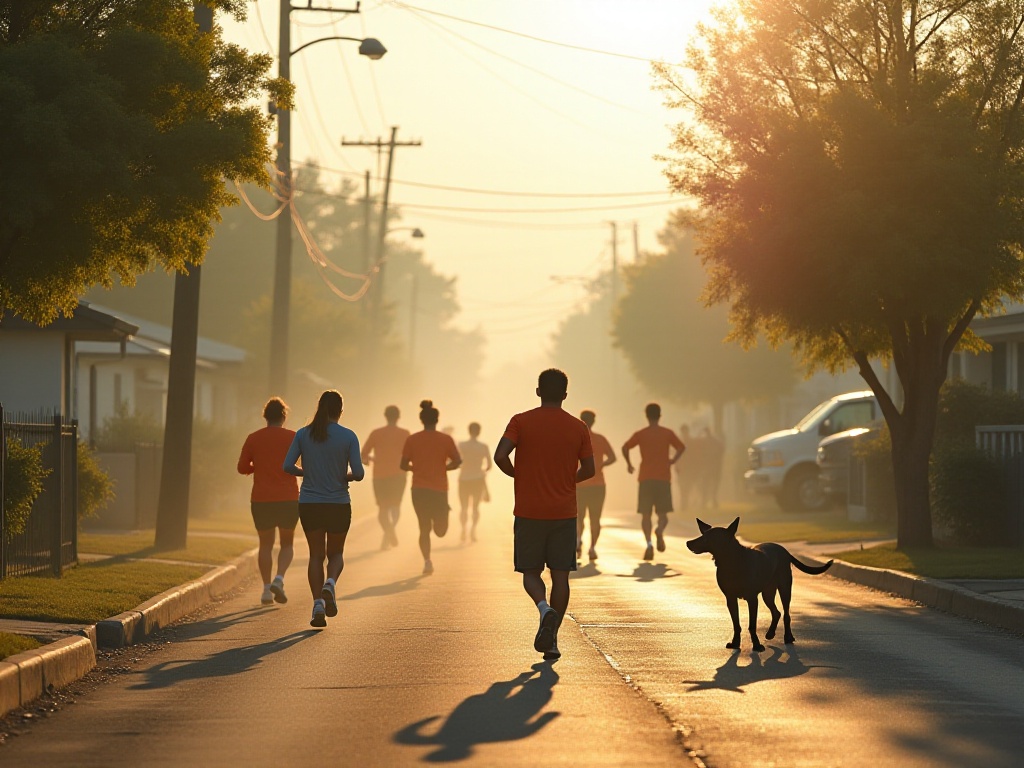Opening Thoughts
I was a typical homebody who used to find even going outside troublesome, let alone exercising. My days consisted of lying in bed, using my phone, watching shows, and following anime series. Extended periods of sitting led to back and waist pain. It wasn't until last year's medical checkup, when the doctor said my weight was severely over the limit and my blood pressure was slightly high, that I realized I couldn't continue like this.
Looking back, I was completely clueless about exercise. I couldn't even walk for ten minutes without getting tired, let alone run. I would get out of breath easily. But after a year of exploration and trial, I not only successfully lost forty-four pounds but genuinely fell in love with exercise. Today, I'll share my journey from being a complete beginner, hoping to inspire others who want to start exercising.

Starting from Zero
I remember my first determined attempt at exercise. I was overly enthusiastic, putting on my new running shoes and rushing to run in my neighborhood. I thought, "People on TV can run several kilometers at once, so I'll try that too." The result was predictable - I was completely winded after less than 500 meters, felt terrible, and the next day my muscles were so sore I could barely get out of bed.
This painful experience taught me that you can't rush into exercise. After researching online, I found that all professional advice emphasized the importance of gradual progress. So I set an incredibly modest goal - just fifteen minutes of walking daily.
Yes, just simple walking. I made a rule: take a walk around the neighborhood after dinner every day. I didn't notice any changes in the first week, but after a month, I found my steps becoming stronger and my breathing less labored. Only when walking no longer tired me did I start trying to jog.
When I first started running, I set a time limit of five minutes. It might sound laughable, but it was truly the most suitable starting point for me. Each week, I would add one minute to my running time. Looking back, these small improvements accumulated in amazing ways - before I knew it, I could easily run for twenty minutes without getting winded.
Intensity Control
Regarding exercise intensity, I must warn everyone: don't try to exercise to exhaustion from the start. I had a colleague who went to the gym for the first time wanting to get six-pack abs immediately. He overdid it and was so sore the next day he felt like he'd been run over by a car, and never dared touch gym equipment again.
There's actually a very practical "10% rule" for controlling exercise intensity. Specifically, if you can run 3 kilometers this week, increase it to no more than 3.3 kilometers next week. It seems like a small increase, but it's actually the most scientific way to progress. That's how I did it, increasing just a little each time, and now I can easily run 10 kilometers.
To think that a year ago, I would be panting like a dog after climbing five flights of stairs, but now I can complete a half marathon. This transformation really gives me a sense of achievement. My method is: first determine your current limit, then break through just a little bit at a time. For running, I would first complete the full distance at my most comfortable pace, and only when that pace felt completely effortless would I slightly increase it.
While running, I discovered a particularly useful judgment standard: the talk test. It's about whether you can maintain a normal conversation while running. If you can barely talk, the intensity is too high; if you can sing, it might be too low. Now when I run, I maintain a pace where I can speak a few sentences intermittently - this ensures I'm neither too tired nor under-training.

Integrating Exercise into Daily Life
Honestly, I think many people have a misconception that exercise requires formal attire and special venues. Actually, I've found that integrating exercise into daily life is particularly practical and easy to maintain.
For instance, I now take the stairs instead of the elevator at work. At first, climbing eight floors was exhausting, but after a month, I completely adapted. Now, climbing stairs every morning has become my fixed exercise routine, and since it's part of my commute, I don't worry about maintaining the habit.
During lunch breaks, instead of playing with my phone at my desk after eating like before, I now walk around the office building with colleagues for twenty minutes. It aids digestion and helps relax. Sometimes we discuss work while walking, which is much more effective than sitting in a meeting room.
When I get home in the evening, I don't immediately collapse on the couch to watch TV. While cooking, I do squats while waiting for water to boil; while watching TV, I do simple stretches on a yoga mat. These are small changes, but when maintained consistently, the results are really noticeable.
You might not realize that these seemingly insignificant activities actually burn quite a few calories. For example, climbing stairs for fifteen minutes burns about a hundred calories. If you do this daily, it's equivalent to running for an hour over a week. Plus, these exercises are particularly suitable for office workers as they don't require setting aside special time and can be done anywhere, anytime.

Social Exercise
The most pleasant discovery I made was that exercise can become a form of socializing. Last year, when I posted on social media about starting to exercise and lose weight, several colleagues commented that they wanted to join. That's how we formed our exercise group.
Every weekend morning, we meet at the neighborhood park to run together. We encourage each other, share exercise tips, and chat about life. When we're tired, we grab coffee together and have a healthy breakfast. This approach works particularly well because everyone shares a common goal, and we keep each other accountable, making it hard to give up.
I've found that exercising with friends really helps you persist longer. Sometimes when running alone, you might want to give up halfway. But with friends nearby encouraging each other, you complete the full distance without realizing it.
We also created a WeChat group where we share exercise data and tips. For instance, when someone breaks their personal record or discovers useful exercise equipment. This sharing not only helps everyone learn but also creates a healthy competitive atmosphere.
Our exercise group has grown from the initial four people to over a dozen. The weekend morning runs have become one of the things I look forward to most. Honestly, without these friends' companionship and encouragement, I probably would have given up long ago.
Equipment Selection
Regarding exercise equipment, my advice is: get what's adequate, but invest where it matters. I learned this lesson the hard way. When I first started exercising, I was reluctant to spend money on equipment and went running in cheap shoes from street vendors. After a month, my knees started aching.
Later, I got a professional foot analysis at a sports store and learned I had flat feet requiring specific types of running shoes. Although professional running shoes are more expensive, my knee problems resolved immediately after wearing them. This taught me that being cheap with crucial equipment ultimately hurts yourself.
However, not all equipment needs to be top-of-the-line. For workout clothes, I think mid-range prices are completely sufficient. The main considerations are breathable fabric and proper fit. I now rotate between three sets of workout clothes, so I don't worry about having clean clothes ready.
Here's a tip about caring for workout clothes: wash them immediately after exercise, don't leave them in your bag until the next day. Sweat stains left too long not only create unpleasant odors but also affect the fabric's performance. I now use special sports detergent and wash in water below 30 degrees to maximize clothing protection.
A fitness tracker is another investment I find particularly worthwhile. It not only records your exercise data but also monitors heart rate and helps ensure appropriate exercise intensity. I check my exercise data daily now, and this visual feedback really helps maintain motivation.
Nutrition
Honestly, before starting to exercise, I had no concept of nutrition. I thought exercise was simply about moving around. It wasn't until I nearly fainted during a run that I realized the importance of proper nutrition.
After researching and consulting professionals, I developed a nutrition plan that works for me. First, pre-workout preparation: I eat easily digestible carbohydrates 1-2 hours before exercising. Usually, it's a banana or whole wheat bread with peanut butter. This prevents feeling too empty while providing enough energy for exercise.
Nutrition during exercise is also important. I now always carry a sports bottle with appropriate amounts of sports drink. For exercises lasting over an hour, I also supplement with energy gels. It might seem troublesome at first, but once you experience the benefits, it feels worth it.
Post-workout nutrition is crucial. My current habit is drinking a protein shake within thirty minutes after exercise, along with some fruit. This helps muscle recovery and reduces next-day soreness. For dinner, I slightly increase protein intake, like eating more chicken breast or fish.
It's important to note that you shouldn't immediately feast after exercising. I made this mistake before, thinking I could eat freely after working out. This not only replaced all the calories burned but added extra ones. Now I adjust my diet based on exercise intensity to maintain energy balance.
Conclusion and Future Outlook
Looking back on this year of exercise, my biggest realization is that exercise isn't actually that difficult - the key is finding what works for you and sticking with it. The transformation from someone who found walking tiresome to someone who can easily complete a half marathon gives me a great sense of achievement.
Exercise hasn't just changed me physically; more importantly, it's changed my mindset. I've become more disciplined and persistent in everything I do. Plus, I've met many like-minded friends through exercise, making life more fulfilling.
Honestly, there are no shortcuts in exercise. It's okay to start from zero, and it's okay to progress slowly - what's important is taking that first step and maintaining forward momentum. Just like how I started with only fifteen minutes of walking and can now complete a half marathon. This gradual change is the most lasting.
If you want to start exercising, try beginning with simple walks. Find suitable exercise methods and intensity levels, and slowly develop exercise habits. Remember, everyone has different starting points and progresses at different speeds. Don't overly pursue others' standards - finding your own exercise rhythm is most important.
I look forward to hearing your exercise stories in the comments - perhaps your experience will inspire more people who want to start exercising. Let's encourage each other and progress together on this fitness journey!


